Flood Safety Week 2025
Flood Safety Week is March 17 to March 23, 2025. This is an opportunity to increase awareness and promote preparedness of flooding hazards also to generate an increase in the level of response to flood watches, warnings, and advisories.
During this week, we will be sending out daily graphics on our social media platforms (Facebook and Twitter). The graphics we plan on sending each day are in the tabs below. Please Share/Retweet to share this knowledge with others.
River Observations and Forecasts
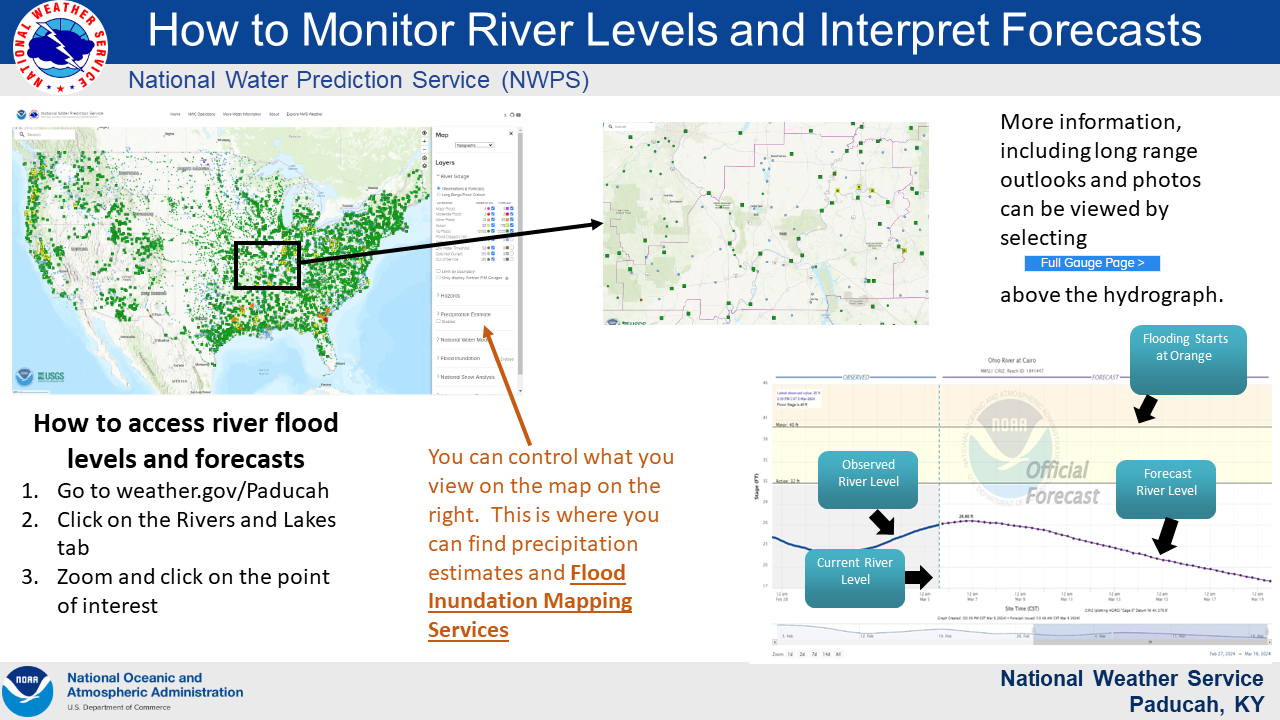
Use this guide to learn how to monitor river levels and interpret river forecasts. The latest river observations and forecasts are one click away on our webpage at weather.gov/paducah.
Have you ever wondered what the different flood stages in river flood warnings mean? This guide explains the differences.
Want to find the latest hydrologic information for our region? Check out our Water Resources webpage! It's a one stop shop for local precipitation data, river levels, and the latest drought information. This page includes a link to the National Weather Service's National Water Prediction Service (NWPS). https://www.weather.gov/pah/waterresources
Water is essential for life on Earth. But in large enough quantities, the very substance we drink and use to grow crops can destroy homes, businesses, and cause fatalities. Learn all about the science of river flooding in the infographic below, and visit weather.gov/safety/flood for flood safety tips.
Turn Around, Don't Drown!
Most flood fatalities occur in vehicles, and it only takes 12 inches of water to sweep a car away. Sometimes the difference between life and death are small decisions. Small decisions like turning around and not driving through a flooded roadway, not driving around barricades, and delaying travel until conditions improve, can make a big impact on whether you keep your car...or even your life. Turn Around, Don’t Drown. weather.gov/safety/flood
"I would have surely lost the vehicle and maybe our lives...just saying 'Turn Around Don't Drown' saved life and property." You never know if the road is even below that muddy water anymore. weather.gov/safety/flood-turn-around-dont-drown
Flash flooding causes many death each year, with many of the deaths being preventable. Most flood deaths occur because people make poor choices while driving. Keep these key safety tips in mind when you are out driving near flood waters.
Flood Terms and Products
A flood WARNING means TAKE ACTION. A flood WATCH means BE PREPARED. When a Warning occurs, it means flooding is imminent or already occurring. When a Flood Watch is in effect, it means flooding is possible in your area. weather.gov/safety/flood-watch-warning
What is the difference between a Flood Watch and a Flood Warning issued by the National Weather Service?
Flash Flood Warning: Take Action! A Flash Flood Warning is issued when a flash flood is imminent or occurring. If you are in a flood prone area move immediately to high ground. A flash flood is a sudden violent flood that can take from minutes to hours to develop. It is even possible to experience a flash flood in areas not immediately receiving rain. Flash Flood Warnings are changing to an Impact-Based format to improve public response.
Flood Warning: Take Action! A Flood Warning is issued when the hazardous weather event is imminent or already happening. A Flood Warning is issued when flooding is imminent or occurring.
Flood Watch: Be Prepared: A Flood Watch is issued when conditions are favorable for a specific hazardous weather event to occur. A Flood Watch is issued when conditions are favorable for flooding. It does not mean flooding will occur, but it is possible.
Flood Advisory: Be Aware: An Flood Advisory is issued when a specific weather event that is forecast to occur may become a nuisance. A Flood Advisory is issued when flooding is not expected to be bad enough to issue a warning. However, it may cause significant inconvenience, and if caution is not exercised, it could lead to situations that may threaten life and/or property.
Flood Safety and Preparedness
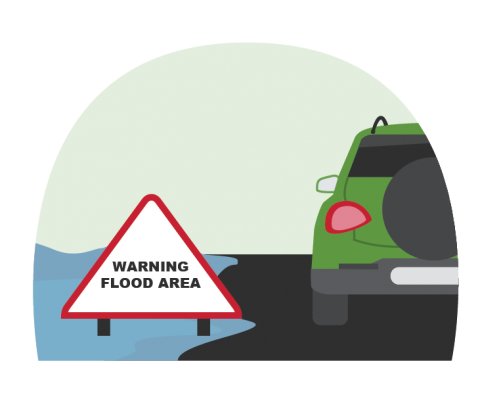
Before a Flood
Types of Floods
Flash Floods
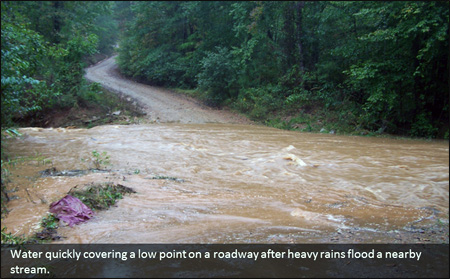
Flash floods are exactly what the name suggests: floods that happen in a flash! Flash floods generally develop within 6 hours of the immediate cause. Causes of flash flooding include heavy rain, ice or debris jams, and levee or dam failure. These floods exhibit a rapid rise of water over low-lying areas. In some cases, flooding may even occur well away from where heavy rain initially fell. This is especially common in the western United States where low lying areas may be very dry one minute, and filled with rushing water from upstream the next.
There are many reasons that flash floods occur, but one of the most common is the result of copious amounts of rainfall from thunderstorms that cause flash flooding. This can also occur when slow-moving or multiple thunderstorms move over the same area. These sudden downpours can rapidly change the water levels in a stream or creek and turn small waterways into violent, raging rivers. Urban areas are especially prone to flash floods due to the large amounts of concrete and asphalt surfaces that do not allow water to penetrate into the soil easily.
Steep, hilly, or mountainous terrain produces rapid runoff and quick stream response, since the water will travel downhill at greater speeds into rivers and over land. Rocky terrain can exacerbate the development of flash floods and raging waters since rocks and clay soils do not allow as much water to infiltrate the ground. Steep, narrow valleys generate rapidly flowing waters that can quickly rise to considerable depth. For instance, a mountain creek that is usually only 6 inches deep can swell to a 10-foot depth in less than one hour.
River Flooding
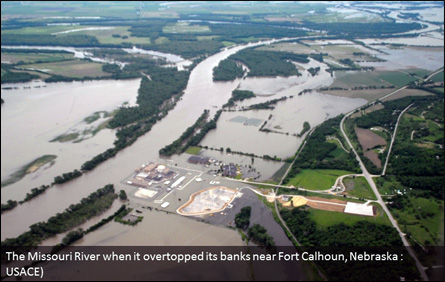
River flooding occurs when river levels rise and overflow their banks or the edges of their main channel and inundate areas that are normally dry. River flooding can be caused by heavy rainfall, dam failures, rapid snowmelt and ice jams. The National Weather Service issues Flood Warnings for designated River Forecast Points where a flood stage has been established.
River flooding is classified as Minor, Moderate, or Major based on water height and impacts along the river that have been coordinated with the NWS and local officials. Minor river flooding means that low-lying areas adjacent to the stream or river, mainly rural areas and farmland and secondary roadways near the river flood. Moderate flooding means water levels rise high enough to impact homes and businesses near the river and some evacuations may be needed. Larger roads and highways may also be impacted. Major flooding means that extensive rural and/or urban flooding is expected. Towns may become isolated and major traffic routes may be flooded. Evacuation of numerous homes and business may be required.
There is an additional level of flooding known as record flooding. In many cases this falls into the major flood category, but it doesn't have to. A record flood is simply one where the water reaches a level higher than it ever has been recorded before. Therefore, record flooding can cause extensive damage or even no damage or other negative impacts at all.
Ice/Debris Jams
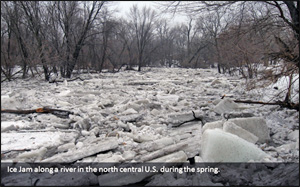
Ice jams are common during the winter and spring along rivers, streams and creeks in the higher latitudes of the continental U.S. as well as in Alaska. Many of the record flood events along major rivers in Alaska are the result of ice jams Debris jams can occur at any time of year and have the same implications as an ice jam. As ice or debris moves downstream, it may get caught on any sort of obstruction to the water flow. When this occurs, water can be held back, causing upstream flooding. When the jam finally breaks, flash flooding can occur downstream.
Typically, an ice jam is resolved when the ice melts. With debris jams, the options are to take measures to remove the jam or wait for the debris to break free. In addition to causing flooding, these jams may also have economic and ecological implications. They might delay or suspend navigation along a waterway, affect hydropower operations, or cause damage to vessels. Jams can cause riverbank erosion, impede migration of aquatic creatures and adversely impact wildlife habitats. Loss of life has also been attributed to flooding caused by ice and debris jams.
Snowmelt and the breakup of river ice often occur at about the same time. Ice jams often form as a result of the sudden push exerted on the ice by a surge of runoff into the river associated with snowmelt. Ice jams can act as dams on the river that result in flooding behind the dam until the ice melts or the jam weakens to the point that the ice releases and moves downstream. A serious ice jam will threaten areas upstream and downstream of its location. Six inch thick ice can destroy large trees and knock houses off their foundations. Once an ice jam gives way, a location may experience a flash flood as all the water and debris that was trapped, rushes downstream.
Snowmelt
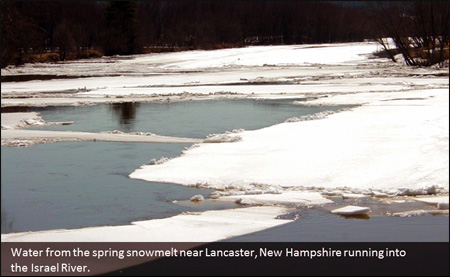
Snowmelt flooding occurs when the major source of water involved in a flood is caused by melting snow. The northern tier states and mountainous areas of the U.S. are particularly susceptible to snowmelt flooding. Unlike rainfall that can reach the soil almost immediately, the snowpack can store the water for an extended amount of time until temperatures rise above freezing and the snow melts. This frozen storage delays the arrival of water to the soil for days, weeks, or even months. Once it begins to melt and does reach the soil, water from snowmelt behaves much as it would if it had come from rain instead of snow by either infiltrating into the soil, running off, or both. Flooding can occur when there is more water than the soil can absorb or can be contained in storage capacities in the soil, rivers, lakes and reservoirs.
High soil moisture conditions prior to snowmelt can contribute to snowmelt flooding. Rainfall during the late fall is particularly important because there is less evapotranspiration and less time for the soil to drain and dry before it freezes. Ground frost or frozen soil is another contributor. Deep, hard ground frost prevents snowmelt from infiltrating into the soil. Cold temperatures prior to heavy snowfall and normal or above normal soil moisture contribute to this.
Deep snow cover can worsen snowmelt flooding since there is more water stored and available for snowmelt. Also, when snow cover is widespread, it usually keeps air temperatures cooler and delays spring warming, which increases the potential for more rapid snowmelt. Rain falling while snow is still on the ground contributes more water for flooding and helps to melt the snowpack, thus rain-on-snow events are watched carefully.
Most often, snowmelt is a relatively slow phenomenon. Snowmelt rates are usually comparable to light or moderate rainfall. Important exceptions to this can occur, especially during unusually warm periods with high dew point temperatures, and when nighttime temperatures remain above freezing. Snowmelt rates can be much higher than normal under these conditions, which can increase the risk of snowmelt flooding.
Dam Breaks/Levee Failure
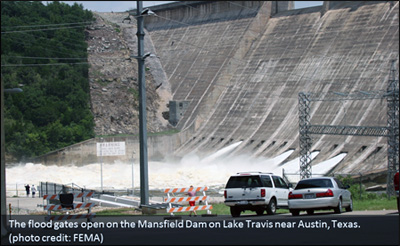
According to FEMA and the National Inventory of Dams (2007), there are more than 80,000 dams in the United States. Approximately one third of these pose a "high" or "significant" hazard to life and property if failure occurs. Dam failure or levee breaches can occur with little warning. Intense storms may produce a flash flood in a few minutes or hours while other failures and breaches can take much longer to occur, from days to weeks.
Causes of dam failure vary from natural causes such as prolonged rainfall, landslides, earthquakes, or erosion to human causes such as improper maintenance and design, negligent operation, or sabotage and terrorism. Dam failures are categorized into three groups: overtopping, in which the water level exceeds the top of the dam; excessive seepage, in which water seeps through the ground; and structural failure, where part of the dam doesn't complete its job sufficiently.
Flood Insurance
No home is completely safe from potential flooding. When just one inch of water in a home can cost more than $25,000 in damage, flood insurance can be the difference between recovery and financial devastation. Visit floodsmart.gov to learn more about flood insurance.
It's important to know what kind of flooding you can expect in your area so that you know how to prepare. Visit weather.gov/safety/flood-map to find out what kind of flooding could impact your home!
If your home or business is in a flood prone area, having flood insurance is one part of having preparedness plan. The more prepared you are, the better you will be at dealing with a severe weather situation. It is crucial that everyone in your household knows the plan and knows how to execute it. ready.gov/make-a-plan
Flood Safety Partners (Click image to be taken to webpage)
Flood information from the United States Geological Survey.
Flood risk management by the US Army Corps of Engineers.
Resources on flood preparedness from the Federal Emergency Management Agency.
Prepare for a flood with information from the American Red Cross.
Flood information and resources for emergency managers from the National Hydrologic Warning Council.
The Silver Jackets bring together from federal, state, territorial, tribal, and local agencies to reduce risks from floods.
 |
Media use of NWS Web News Stories is encouraged! Please acknowledge the NWS as the source of any news information accessed from this site. |
 |